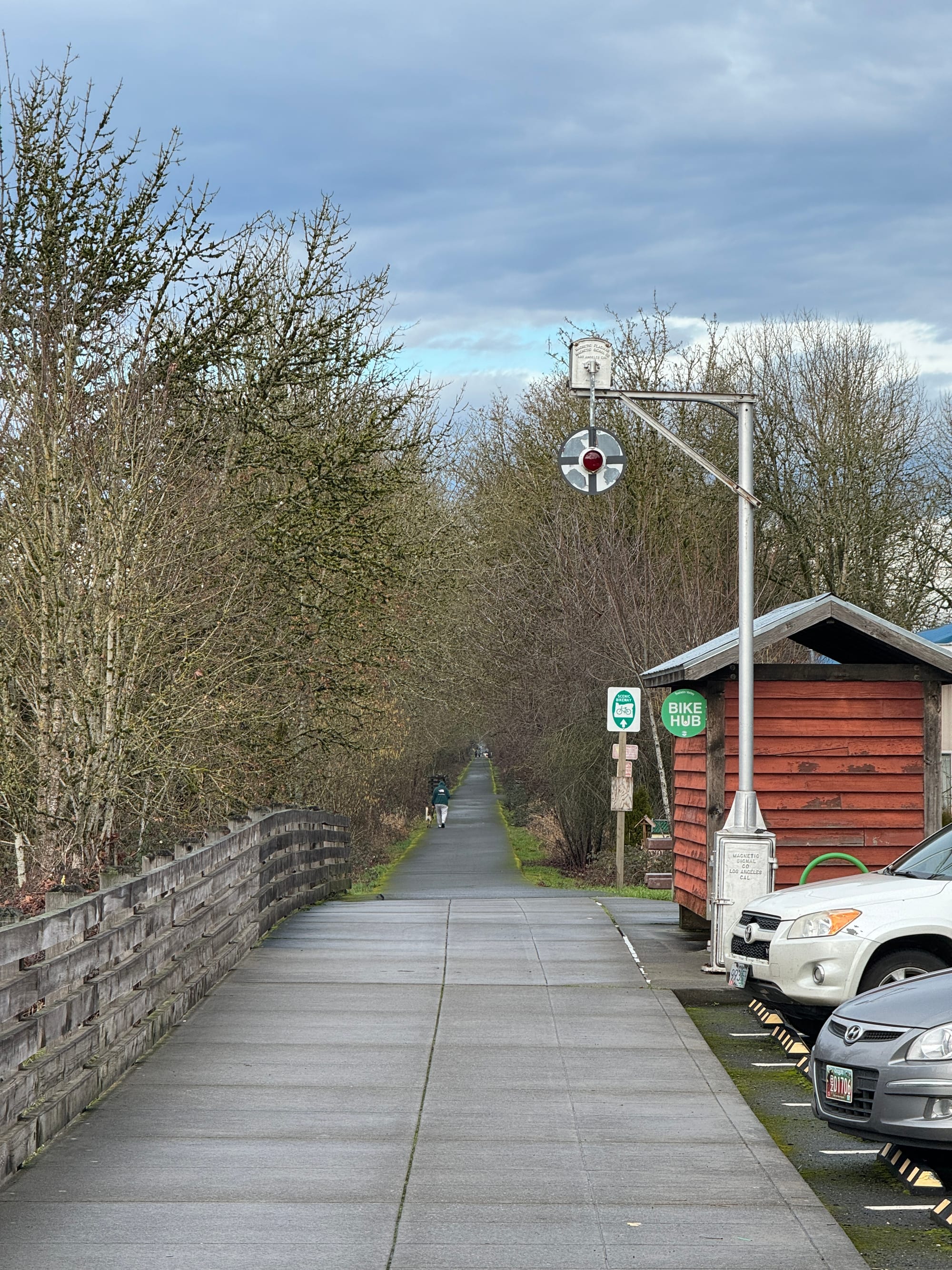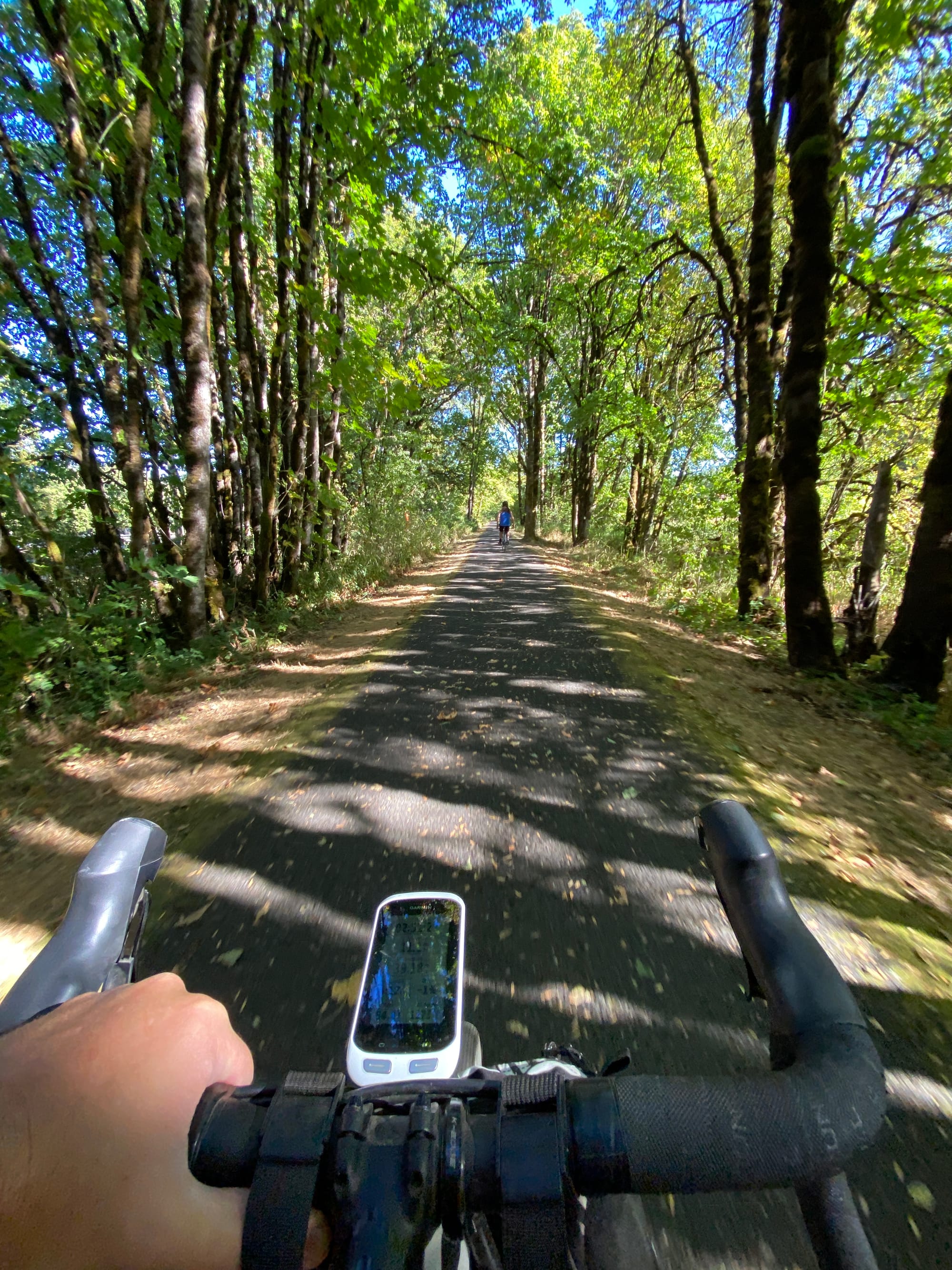Rails to Trails recreation paths are amazing but it sucks that they take forever to build

Every couple years I set aside a whole day for riding my bike outside of Portland, Oregon on the Banks-Vernonia trail. I think I've done it four times now.

It's about 22 miles between the two towns, and I always park at the Banks trailhead, pull out my bike, and ride north (and slightly uphill) for a couple hours. Vernonia is a lively little former-sawmill town with tons of restaurants and food trucks and for the last couple years I've stopped at one that makes the best Baja-style fish tacos I've ever had in Oregon. After lunch, I get back on the bike and roll the twenty miles back to the start.
The trailhead is about an hour from my house, and with the long ride and the lunch break and the drive back, it's typically a 9am-3pm day spent all on one ride.

Honestly, I wish there was high-speed rail criss-crossing this entire nation to make travel easier for all, but the fact is we have thousands of miles of unused, decommissioned railroads all over the US, just rusting away, unused.
A former railroad makes for an incredible recreational walking and biking path.
- Trains can't climb more than 5% grades so the hills are never too bad
- Trains can't turn tightly without derailing so any changes in direction are fairly smooth and slight.
- Train tracks are typically near roads designed for cars, but off-highway completely in your own world, just a few hundred yards away.
In terms of cost, it's ridiculously cheap compared to common infrastructure construction projects. Most railways get converted easily with a strip of pavement laid over the railbed. In Oregon, we typically build a few bridges because the 100+ year old railroad bridges are usually decayed and not ready for foot traffic.



Photos of the trail from my January trip along the trail
The Banks-Vernonia trail cuts deep into the ferns and trees between two former timber towns, and honestly it feels like you're riding in a forest all to yourself, especially in winter months when hardly anyone is around (summer weekends can be crowded, but everyone still has a good time). On my ride there last month, I realized I spent $80 that day, spending $10 on tacos and a drink in Vernonia and $70 in gas in Banks before driving home.
The first time I ever set foot in Vernonia was around 2004, only shortly after the trail opened, and I remember it was a Saturday and nothing was open in Vernonia. I recall this clearly because I was starving after a bike race nearby that was held in a rock quarry, but every coffee shop and restaurant back then had Monday-Friday only hours. I ended up driving south and getting a regrettable meal at a Dairy Queen drive-thru because that was the only food option around within a half hour's drive (I remember this vividly because I felt horrible after and I've never eaten anything besides ice cream at a Dairy Queen since).
Great, why aren't these around everywhere?!
There's an old railroad that hasn't seen a train since 1985 near me, and I've been speaking at and attending meetings about someday turning it into a recreational path for the better part of a decade already. In that time, I learned the Banks-Vernonia trail was slated for getting built in the early 1990s, but wasn't completed until around 2003 because the couple dozen farmers that lived along it consistently complained about it and sued the county and state to try and block it. Still, a decade and a half later, it welcomed thousands of people to enjoy the path and to this day the towns on both ends are definitely booming from the uptick in visitors.
At one of the public hearings, I heard the story of the Banks-Vernonia trail from a resident who grew up as a kid on a farm that abutted the route. His parents took part in lawsuits as all the farmers collectively dragged their feet to fight the trail tooth and nail, delaying it by almost a decade. I remember him saying the county even footed the bill for custom fences along the route that passed their farm, on the order of $10k worth of construction, just to move the project forward. He closed his comments by saying he and his parents regretted it ever since, that 15 years later, they could see what a great thing the trail was for everyone using it.
What about the farmers?
When you're talking about miles of glorious off-highway recreational trail, it's easy to say the two dozen or so property owners along the path should probably take a backseat to the huge tourism upsides for the region, but I've sat through hours of people opposing these, and I'll summarize most of their feedback as:
- Angry about strangers being where there was nothing before in their backyards
- Concerns about "crime" or "homelessness" clogging the path
- Worries about the loss of "their" land
But the facts aren't on their side. The rails-to-trails project near me uses a small strip of land farmers haven't ever been able to plant on or use in their production for decades. Every property owner bought land with a permanent easement for the railroad, and since they've dismantled the tracks, farms have left the 20ft wide or so path fallow. While there is crime on some bike paths in eastern Portland, those are smack dab in the middle of a city environment, making them great places to temporarily camp. The rails to trails in Banks and near me are miles from anything, and not a place people would live since it requires so much travel to get your basic needs met. At one public hearing, a trail opposition group invited a sheriff from Banks to speak and when he was asked how many times the police have been called to the trail he said the answer was "zero" in 15 years of time on the force.
The wheels of justice turn slowly
There are hundreds of miles of rails-to-trails in the midwestern US, and I have friends that spend entire summer vacations riding around Illinois and Wisconsin on them. The Banks-Vernonia trail eventually got built and is used by many, and I've heard from people behind the Yamhelas Westsider Trail that they expect another 5-10 years of lawsuits but they will ultimately prevail.
I admire the upbeat nature of the trail organizers, especially against the backdrop of a small but vocal farmer contingent that protests the trail any chance they get, and a set of county commissioners that became majority right-wing and voted into office thanks to opposition to the trail as their number one campaign promise.
The sad fact is I used to go on weekly group rides organized by my local bike shop here in town, but they faded away years ago since there are virtually no bike lanes around and we had numerous altercations with angry drivers while out as a group. It also didn't help that occasionally a regular rider would show up on a brand new bike because they'd been hit by a car and got it replaced by insurance.
I'd love it if there was a 20-mile off-highway path close to me that I could ride any time, today, and without having to schedule a whole day around. I'm now in my early 50s and finding good places to exercise out in nature isn't easy. I'm sure I'll get to enjoy it in another 5 or 10 years, but it's kind of a bummer how a few landowners can keep tens of thousands of annual visitors from enjoying their time outdoors.





Shots from previous trips on the Banks-Vernonia trail over the years

